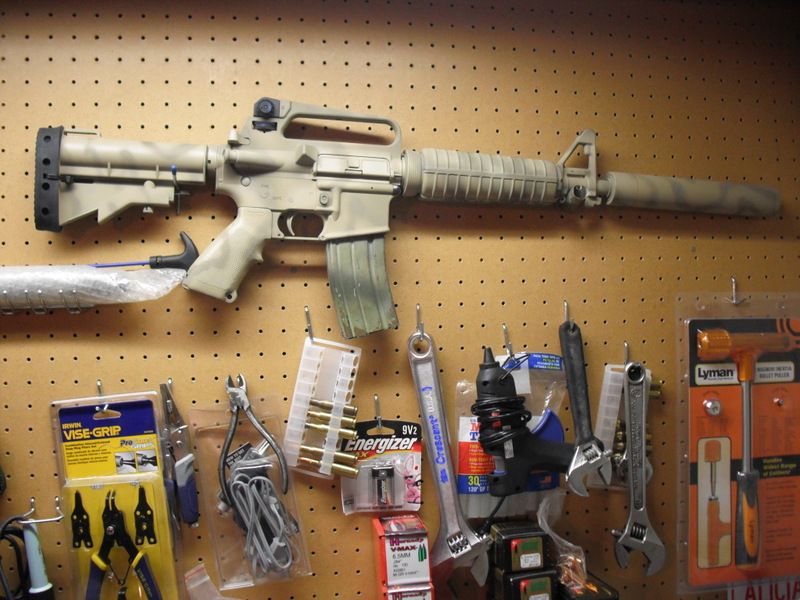Re: What yard zero are you guy's using 100,200, or 300
Did the OP say he's using an AR with iron sights, RDS, or magnified optic?
For a <span style="font-weight: bold">practical carbine </span>or rifle with <span style="font-weight: bold">RDS/irons </span>that is intended to be used for engaging targets of opportunity within the common distances in an <span style="font-style: italic">urbanized area</span>, a 200m zero is preferred by many for this main reason:
Targets of opportunity don't often stand out, form of an E-type, square off to you, and take a tactical pause so you can get in position, settle the gun, think about your holdover from a 25/300m BZO, and make that nice center of mass shot on a balmy range day.
You often get heads peeking out from behind real cover, maybe a hand on a weapon exposing itself unknowingly to your position, the top of a head as the target squats behind a wall...in short, not a full E-type sil saying, "Shoot me."
The 300m zero will screw you over hard in those scenarios, and don't think that you'll just dial or hold over quickly when the targets are shooting back from UKD. It can be done, and you should absolutely know your holds, but for within 250yds, you will be within a 4" trajectory using a <span style="font-weight: bold">50yd zero</span>, or roughly the average width of a vital zone on a human skull.
The 50yd/200yd zero also makes an awesome <span style="font-weight: bold">hunting PBZ </span>for the same reason. You're within the 10" vital zone on most medium game, and don't need to take your focus off the target to dial, or think about elevation holds, since even a full value 10mph wind will still not blow your projectile much more than 5" from POA at 250yds, so you can hold into the wind on the vital zone of the game and get a nice hit.
This 50/200yd zero is a great practical solution for a RDS-equipped carbine.
For a <span style="font-weight: bold">rifle or carbine </span>saddled with a <span style="font-weight: bold">magnified optic</span>, the reticle and intended engagement distances are going to drive a lot of your zero solution approach. I personally use a 100yd or 100m zero, due to elevation changes that I frequently encounter going from 5400ft ASL, up to 6400 or 6600 ASL, then down to sea level throughout the year with my precision guns. Density altitude is a real factor with those air pressure ranges, so it makes sense to zero at 100yds or meters, and run my dope off that zero.
For optics with specific BDC stadia like the ACOGs, GRSC, Short Dot, etc., they usually go off the 100m zero for center intersect of the crosshairs or primary aiming point, then you have what you have for graduated stadia lines calibrated at 200, 300, 400, 500, (and sometimes 600-800m) for a military-purposed optic.
If you're shooting leg matches with your <span style="font-weight: bold">CMP</span>, tricked A2-style match gun, with heavily worked M16A2 rear sight look-alike assembly, fine peep sight or lens, balanced sight housing, with finer MOA increments than an issue gun, floated barrel, weighted stock and guards, shooting jacket, sling, mitten, hand loads pushing 77gr Scenars or SMK's for the 200yd and 600yd lines, you will be intimately familiar with your elevation and windage knobs, and exactly where you POA/POI relationship is with that rifle, especially after your first shot.
I don't see a lot of people using the M16A2 elevation and windage wheel assemblies on their fighting guns, but if you do have a KISS carbine or AR15 with fixed A2 or A4 detachable sight housing/"carrying handle", yes, it's great to know your trajectory and elevation settings with that system, especially if you live west of the Mississippi and have a lot of open or mountainous terrain in your geographic area.
On one of my KISS guns with the A2 upper, I have those markings clearly paint-filled so I can use them at distance, but I probably will slip the scales so that I have a 200yd zero with that system too, as there is no way it will ever be used in a CMP match with a short barrel, telestock, M4 barrel, etc. Mine is just a retro project that I plan to shoot next to my modern carbines for comparison and fun.
For the Eotech hold-offs that were referenced, imagine only the head of that silhouette visible, then see how well the holds work, especially at 50 and 100yds-you're out of a good impact solution at 50, and off the head entirely at 100yds.
In Travis' video, he is again talking about a "combat effective zone" on a human silhouette, and the 25yd zero, which works if you have a torso to shoot at out to 400yds without need of holdover and perfect wind conditions, since the 300yd POI in his demo was in the neck of the 3D TGT, which is usually a miss on even a standing static human, since there is a bit of sway and natural head movement with humans that are standing and talking, let alone walking or running and ducking from your doom stick. Think about how the 200yd zero would work in the video, and when you would need to start holding at distance, compared to how the 25yd zero does on a head. It is a great video that brings the OP's question up, and a great discussion.
<object width="425" height="350"> <param name="movie" value="http://www.youtube.com/v/8iCNIRuQuBg"></param> <param name="wmode" value="transparent"></param> <embed src="http://www.youtube.com/v/8iCNIRuQuBg" type="application/x-shockwave-flash" wmode="transparent" width="425" height="350"> </embed></object>




